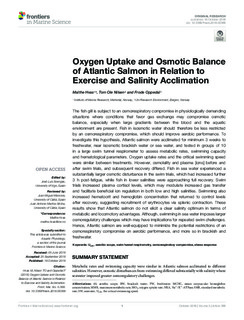| dc.description.abstract | The fish gill is subject to an osmorespiratory compromise in physiologically demanding situations where conditions that favor gas exchange may compromise osmotic balance, especially when large gradients between the blood and the aquatic environment are present. Fish in isosmotic water should therefore be less restricted by an osmorespiratory compromise, which should improve aerobic performance. To investigate this hypothesis, Atlantic salmon were acclimated for minimum 3 weeks to freshwater, near isosmotic brackish water or sea water, and tested in groups of 10 in a large swim tunnel respirometer to assess metabolic rates, swimming capacity and hematological parameters. Oxygen uptake rates and the critical swimming speed were similar between treatments. However, osmolality and plasma [ions] before and after swim trials, and subsequent recovery differed. Fish in sea water experienced a substantially larger osmotic disturbance in the swim trials, which had increased further 3 h post-fatigue, while fish in lower salinities were approaching full recovery. Swim trials increased plasma cortisol levels, which may modulate increased gas transfer and facilitate beneficial ion regulation in both low and high salinities. Swimming also increased hematocrit and hemoglobin concentration that returned to control levels after recovery, suggesting recruitment of erythrocytes via splenic contraction. These results show that Atlantic salmon do not elicit a clear salinity optimum in terms of metabolic and locomotory advantages. Although, swimming in sea water imposes larger osmoregulatory challenges which may have implications for repeated swim challenges. Hence, Atlantic salmon are well-equipped to minimize the potential restrictions of an osmorespiratory compromise on aerobic performance, and more so in brackish and freshwater. | |
